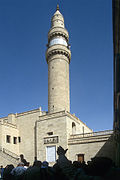Top Qs
Timeline
Chat
Perspective
List of Islamic structures in Mosul
From Wikipedia, the free encyclopedia
Remove ads
This is a list of Islamic structures in Mosul. Islam is the majority religion in Mosul. Muslims of Mosul are predominantly followers of Sunni Islam, with a minority of Shi'ites.

Remove ads
Modern mosques
Mosul Grand Mosque: Situated in the Taqafah district bordering the Tigris river near the Nineveh archaeological site. Its construction started during the rule of Saddam Hussein, but just like the Al-Rahman Mosque, the construction was interrupted because of the political instability in the country. The mosque remains incomplete to this day.
Historic mosques and shrines
Remove ads
Castles and fortresses
Qara Saray (Black Palace): Built in the 13th century by Badr al-Din Lu'lu. Damaged during the Mongol invasions via burning.

Other monuments
Tomb of the Girl: A small domed memorial believed to be built over the grave of a female mystic, located in the middle of a street near Bab Sinjar. Historical research proves that it was built over the grave of the historian Ibn al-Athir, which the government has officially stated, with a stele built on the tombstone to indicate his burial there. Bulldozed in 2014 by the Islamic State of Iraq and the Levant.
Remove ads
See also
References
Wikiwand - on
Seamless Wikipedia browsing. On steroids.
Remove ads












